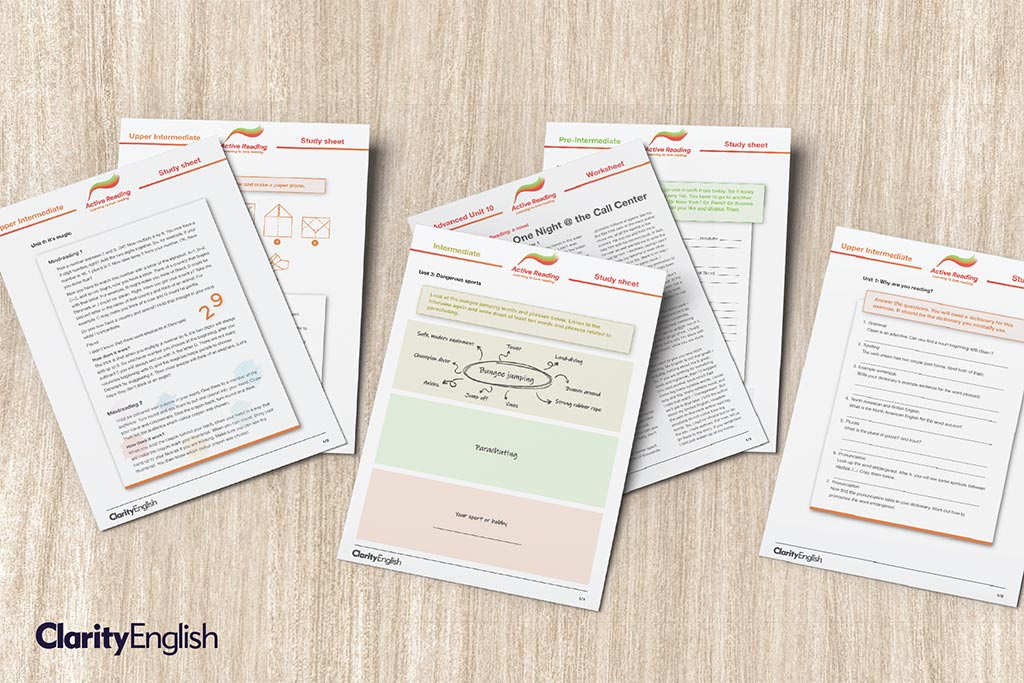Over the past few months, the editorial team at Clarity has been updating the study sheets at all levels of Active Reading. The study sheets are designed to consolidate the skills students learn through the program, as well as giving teachers support materials they can use in and out of class. However, the updating process raised an interesting question – why are we including print materials in a digital resource?
Following the mass migration to online learning we have seen over the past two years, some academics suggest a return to the ‘regular’ classroom would be not only impractical but undesirable. Online learning has meant increased accessibility to resources and greater flexibility, for both students and teachers, through asynchronous learning.
But in reality, it appears these reasons are not enough to fully commit to the digital classroom. ‘After 18 months of grappling with online resources, a lot of my colleagues are returning, at least partly, to paper-based teaching.’ shared Alison Moore, a language teacher from a secondary school in Reading, UK. Why might this be? Well, in their opinion there are some things that are just better on paper. The research confirms this.
1. Reading: Skimming vs storing
How we read changes depending on the medium we use. Research by Naomi Baron, from the University of Washington, suggests that because we are used to reading short and easy-to-understand content online (i.e. social media posts and texts), our brains are adapted to reading quickly, and are pre-set to skim when reading online. That’s not to say students can’t concentrate on long texts when reading digitally. It just takes more effort.
When you have limited time in a classroom, you want your students to get the most out of the time they have with you. Using paper-based texts appears to be a shortcut to engage that concentration more quickly, and activate that deeper text comprehension.
2. Note-taking: Long term memory
There is well-documented research that suggests taking notes on paper is better for committing information to students’ long term memory. While it is possible to transcribe a higher volume of information through typing, these notes are often written verbatim. Mueller and Oppenheimer (2014) found that students who took long-hand notes performed better than digital note-takers when answering conceptual questions. They attributed this difference to long-hand note-takers reframing information in their own words resulting in a deeper learning process.
3. Distractions: Choice overload
Teachers have choice overload when it comes to educational programs, websites, and apps. There are hundreds available to incorporate into lessons or for homework – just search ‘IELTS support’ and you’ll see for yourself. Using a mixture of the best ones may seem like a great idea – after all, you’re utilising the internet medium and keeping your class engaged.
In actual fact, you may be doing just the opposite. Using several different sites in your lessons may force students to engage in ‘task switching’. We all have a certain concentration capacity. When students shift their attention from one site or task to another, they are draining their mental battery with every switch. Too much task switching leads to information overload and mental fatigue. The best way to keep your students actively engaged may be to pool all this information into one place. You could even put it in a worksheet.
The widespread adoption of online materials and programs has changed education forever. The digital world and its resources will only grow, continue to be more accessible and provide more learning opportunities in the future. But the academic research and experience of teachers inform us that all is not lost with paper. When choosing resources your options are not binary, all or nothing, digital or paper. You can still digitally develop while preserving the page.
You can take a look at the new Active Reading worksheets (and the rest of the program) here.

